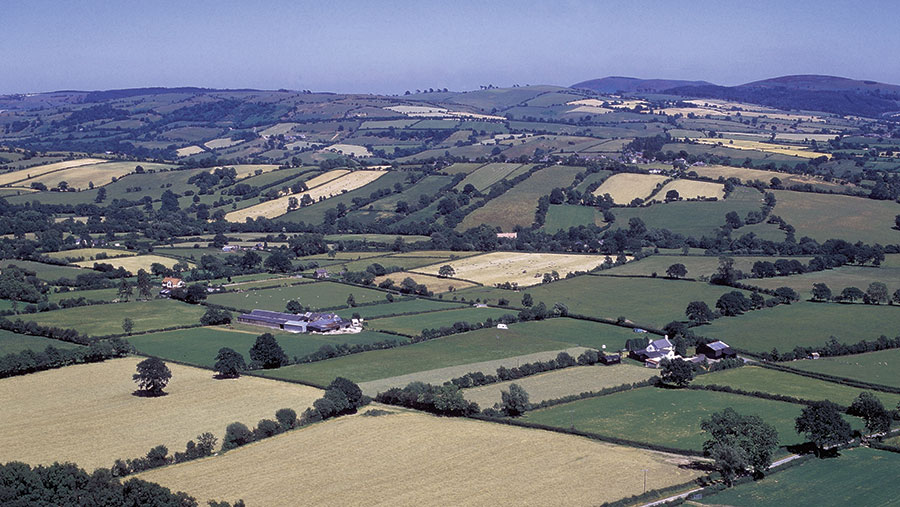County farms estate shrinks further as sell-off continues
 © Photofusion/Shutterstock
© Photofusion/Shutterstock The size of the county farms estate in England continues to decrease as local authorities choose to dispose of their land in favour of a one-time cash payment.
The 69th Annual Report to Parliament on Local Authority Smallholdings in England (1 April 2018 to 31 March 2019) includes data from 39 authorities that responded to the Chartered Institute for Public Finance and Accountancy (Cipfa) survey – 43 were approached.
However, in some cases, the submitted data sets were incomplete, making it difficult to draw a direct comparison with previous years.
See also: Agriculture Bill proposes significant changes to tenancies
As of 31 March 2019, the total area of land held by the 39 authorities in England that responded was 201,117 acres (for the whole estate), of which 191,171 acres were let as smallholdings (for 38 reporting authorities).
In comparison, last year’s report showed land held by local authorities totalled 220,000 acres, almost 9% more, of which 206,580 acres were let as smallholdings.
However, three fewer authorities responded this year, which the Tenant Farmers Association (TFA) called a major disappointment.
Land changing hands
The report’s data on acquisitions and disposals indicates a decrease in the area of land held by smallholdings authorities of 1.4%. The previous year saw a decline of 2.8%.
George Dunn, TFA chief executive, said: “It should be an absolute requirement for local authorities to provide this data to Defra.
“While it looks like there has only been a small year-on-year reduction in the area of land owned by smallholding authorities, there has been a reduction of 72 tenants.
“However, how certain can we be about this when local authorities do not treat this matter sufficiently seriously?”
A total of 257 acres were acquired by three smallholdings authorities and a total of 3,126 acres were sold or otherwise disposed of by 22 smallholdings authorities in 2018-19, according to the report.
Norfolk County Council bought the majority of these acres (247), as it did in the previous year, when it bought 440 acres of the total 465 acres acquired.
Chester West and Chester Council disposed of the greatest area (670 acres), with Somerset County Council not far behind (605 acres).
Staffordshire County Council is recorded as owning 8,256 acres on 114 holdings, receiving almost £1.16m in rent in 2018-19.
However, this is sure to change dramatically in the next report, as in February 2019, it announced plans to sell 1,700 acres, comprising 16 holdings, seven of which came to the market in October.
In comparison, a total of 6,852 acres was sold or otherwise disposed of by 24 smallholdings authorities between April 2017 and March 2018.
Over the same period the year before, the total area of county council farms in England shrank by 2,217 acres.
Disparity in estate sizes
The 38 authorities that provided data reported they owned and let 2,400 smallholdings as of 31 March 2019.
Farm business tenancies represented 62% of the agreements, with 14% of these running for less than five years.
A total of about £23m in rent was due for the holdings and the average rent was £121/acre.
Cambridgeshire County Council continues to own the largest farms estate in the country by a big margin. It lets 32,171 acres in 251 holdings, receiving almost £4.17m in rent. The next-largest estate is Lincolnshire County Council, which owns a total of 18,753 acres.
At the other end of the scale, West Berkshire Council, Milton Keynes Council and Hartlepool Borough Council each owns just five acres.
Some are recorded in the report as having no data available, such as Herefordshire Council, which sold off its entire estate over the past few years.
In total, authorities in England had a farms revenue account net surplus of £8.93m.
Chris Cardell, NFU tenants’ forum chairman, said: “As always, the county farms survey shows the service continues to deliver value, and this can be shown by the establishment of 39 new entrants into farming businesses.
“The general trends indicate yet another year of surplus income being returned to the councils involved, after taking account of non-core income that varies from year to year.
“Thankfully, the value of the county farms structure is well recognised by this government and reference to its importance can be found in the Agriculture Bill.”
